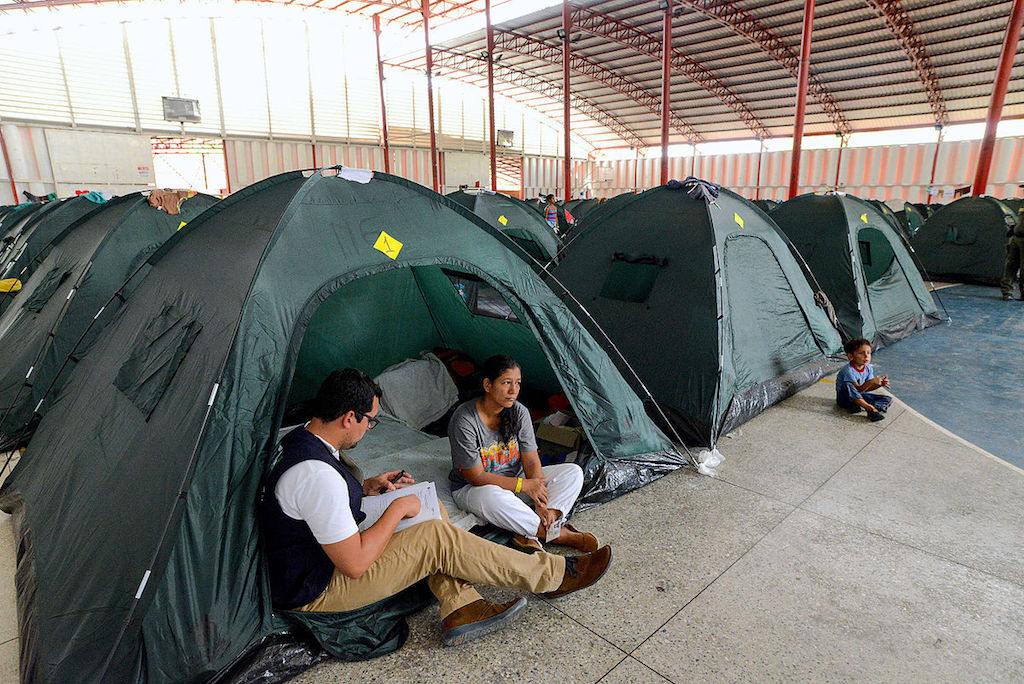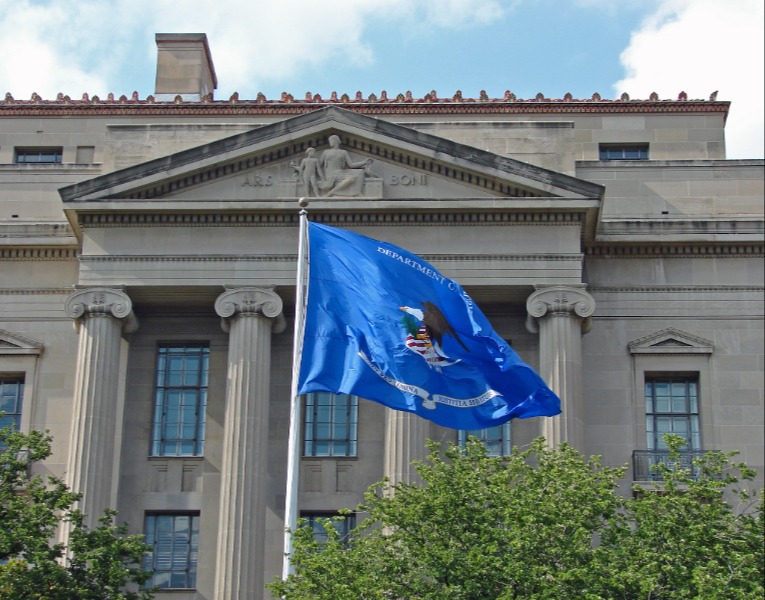Venezuela: A Refugee Crisis in for the Long Haul
For the past two years, the Trump administration has focused on slashing the number of refugees entering the United States, dropping the cap from 85,000 in 2016 to just 30,000 for 2019. These efforts have singled out top-sending—and predominantly Muslim—countries including Syria and Iraq. Yet, in the past two years, new refugee crises have popped up throughout the world; one of the most quickly unraveling of which is just across the Caribbean Sea in Venezuela.

Published by The Lawfare Institute
in Cooperation With

For the past two years, the Trump administration has focused on slashing the number of refugees entering the United States, dropping the cap from 85,000 in 2016 to just 30,000 for 2019. These efforts have singled out top-sending—and predominantly Muslim—countries including Syria and Iraq. Yet, in the past two years, new refugee crises have popped up throughout the world; one of the most quickly unraveling of which is just across the Caribbean Sea in Venezuela.
The Venezuelan crisis evolved from slow-moving state collapse. Economists, analysts and humanitarian advocates repeatedly warned that the combination of Venezuela’s unsound fiscal policy, deepening corruption, entrenched authoritarian practices and risky reliance oil exports had potentially dire consequences. These consequences crystalized into reality nearly four years ago. As the price of oil plummeted from $96 per barrel in 2014 to just $49 per barrel in 2015, Venezuela’s government coffers almost immediately emptied out. The Maduro regime, desperate to continue its patronage policies, printed more money. The result was soaring inflation rates, with the International Monetary Fund now estimating that inflation will hit 10 million percent in 2019. Money needed to buy basic items is now more easily weighed than counted. For example, this year, a chicken reportedly cost more than 14 million bolivars, the bills for which weigh more than 32 pounds. To reduce these heavy costs, the government cut five zeros from the bolivar currency in August and raised the minimum salary by 3,000 percent.
Despite these recent changes, the crisis is only getting worse. In the last year alone, Venezuelans lost on average 24.1 pounds (11.4 kilograms), and 87 percent of households were living below the poverty line. In the last two months, naval hospital ships from the United States and China have docked in Colombia and Venezuela to provide medical care and food supplies. Additionally, access to medicine and medical care is limited at best. A recent Inter-American Commission on Human Rights report found that Venezuela has only 20 percent of the medicines needed to treat high blood pressure or elevated sugar levels—two of the most pressing medical needs of Venezuelan citizens. The struggles in Venezuela are not merely a lack of social services and humanitarian goods, but also increasing violence and authoritarian pushback from the Maduro regime.
Nicolas Maduro’s election in 2013 only heightened an already repressive political environment, cultivated during the late president Hugo Chavez’s fourteen years in power. Maduro was re-elected to a second presidential term in May 2018, through an election that the international community widely considered undemocratic and fraudulent. As the economy collapsed, the opposition has become increasingly vocal. In response, the Venezuelan government has tamped down on dissident activities and has taken extensive measures to silence discontent, including detaining dissidents. In one recent and particularly disturbing episode, opposition leader Fernando Alban was detained and reportedly committed suicide while in police custody. The administration is also allegedly taking more drastic measures by carrying out extrajudicial executions of dissidents. A September 2018 Amnesty International report claims that some 8,292 extrajudicial executions were carried out between 2015 and 2017.
These reports come as the Maduro regime is increasingly implicated in illicit activities including drug trafficking, corruption and money laundering. On September 25, the U.S. Treasury Department sanctioned President Maduro’s wife, Cilia Flores, and three other individuals for allegations of corruption. These latest sanctions bring the total number of Venezuelan nationals sanctioned by the United States up to sixty-six, most of whom occupy positions of power within Venezuela’s political elite. With no way to access basic services, to affect change from within, or to counter the illicit activities carried out by the Maduro regime, Venezuelans have begun leaving the country on a massive scale.
Between an attempted coup to overthrow Maduro and the continued flight of thousands of refugees, August 2018 seemed to serve as the tipping point for the international community in recognizing the Venezuela crisis. In August alone, tens of thousands of migrants crossed into Ecuador and Peru, forcing both countries to temporarily close their borders as immigration officials were completely overwhelmed. In Brazil, the military was deployed to the Venezuelan border after riots broke out and local residents destroyed makeshift refugee camps. Over the next month, there were calls for action from the European Union; the United States; and, of course, Venezuela’s regional neighbors. This string of events has inspired comparisons between the Venezuela refugee crisis and the refugee crisis sparked by the Syrian civil war.
With that in mind, where are we now? Between 2.3 and 3 million Venezuelans have now left their country since 2014. As of August 2018, at least seven percent of Venezuela’s total population (as measured in 2014) had fled, and at least 5,000 more Venezuelans leave their homes every day. Assuming that this migration rate continues, 1.8 million Venezuelans will have left their homes in 2018. As of last year, Venezuela was the fourth most prevalent refugee sending country in the world—behind only Syria, Afghanistan and Iraq. But with no end in sight, Venezuela’s crisis is in fact on track to become one of the largest national exoduses in world history.
An estimated 90 percent of Venezuelan refugees are migrating to countries within South America. Precise figures are difficult to calculate given the transient nature of forced migration, but neighboring Colombia is estimated to host between 600,000 and 1.1 million Venezuelans. Another estimated 400,000 Venezuelans are in Peru, while Ecuador—a country with only 16.4 million citizens—reports that at least 547,000 Venezuelans entered the country between January and August of 2018. Another reported 50,000 refugees have crossed into Brazil, which also shares a border with Venezuela; however, many Venezuelans in Brazil, Ecuador and Peru will continue their transit into Chile and Argentina. Those who do migrate outside of South America are primarily traveling to Spain, Central America, Mexico and the United States.
The United States is estimated to receive between only 1 and 5 percent of all Venezuelan refugees leaving their country. Even with this small percentage, Venezuela is now the U.S.’s top sending country for asylum seekers, with more than 13,000 asylum claims lodged between January and June of this year. In fact, since December 2017, asylum claims from Venezuelan nationals have either surpassed—or been roughly equal to—all asylum claims from the Northern Triangle countries of Guatemala, Honduras and El Salvador combined. The United Nations High Commissioner for Refugees estimates that almost 73,000 Venezuelan asylum claims have been lodged in the U.S. since 2014.
There is no clear consensus on what next steps the international community should take to address Venezuela’s collapse or the resulting refugee crisis. On September 21, Secretary of State Mike Pompeo announced that the United States was preparing a “series of actions” directed at the Maduro regime. Three days later, Democratic Senator Bob Menendez of New Jersey presented a $58 million plan to tackle the Venezuela crisis. The bill would authorize $40 million for humanitarian aid, place harsher restrictions on individuals already sanctioned by the U.S. and require the Department of Treasury to publish information on Maduro’s frozen assets. Stronger sanctions and increased humanitarian aid are not the only policies on the table.
Increasingly, members of the international community are offering support for foreign military intervention. President Trump first promoted his support for a potential military option more than a year ago. The Secretary General of the Organization of American States, Luis Almagro, also failed to rule it out during a press conference in September. While humanitarian aid and sanctions alone might not topple the Maduro regime, foreign military intervention brings with it a host of other challenges. First, in the immediate aftermath of a regime change, violence would surely trigger an even larger wave of migration. Second, this move would leave open the question of who would replace Maduro as president; this is complicated by the fact that many ruling elite and opposition figures also have ties to illicit activities. Third—and perhaps most important—the Venezuelan state has been destroyed, meaning that it will take years to redevelop the state institutions and economic opportunities necessary for the state to once-again operate independently. In short, even if a regime change took place tomorrow, Venezuelan refugees would continue fleeing the country for years to come.
There have also been a series of international responses to the refugee crisis. On Aug. 31, the European Union announced a $41 million aid package to provide Venezuela with much needed food and water. On Sept. 3 and 4, Ecuador hosted a summit with eleven Latin American nations to discuss the crisis. The participants—Argentina, Brazil, Chile, Colombia, Costa Rica, Ecuador, Mexico, Panama, Paraguay, Peru and Uruguay (Bolivia attended but did not sign the agreement)—released an eighteen-point declaration. The declaration promised to provide medical care, public education and work opportunities to Venezuelans; to accept expired travel documents; to allocate funds to the most overwhelmed immigration agencies or regions; and to fight human trafficking, migrant smuggling and discrimination against Venezuelans. This cooperation demonstrates a positive step in regional solidarity with refugees, but ultimately fails to address the origins of Venezuela’s mass migration.
As it stands now, options are limited for addressing the Venezuela crisis, and in the meantime thousands of Venezuelan refugees will continue to flee every day. While Colombia will disproportionately feel the effects of the crisis, the United States can expect to be confronted with an increasing number of Venezuelan refugees—especially as Latin American countries’ capacities to absorb future refugees dwindle. Without any immediate solutions on the table, the crisis in Venezuela is likely to intensify, continuing its trajectory toward utter state collapse and growing into one of the largest mass migrations in history.





